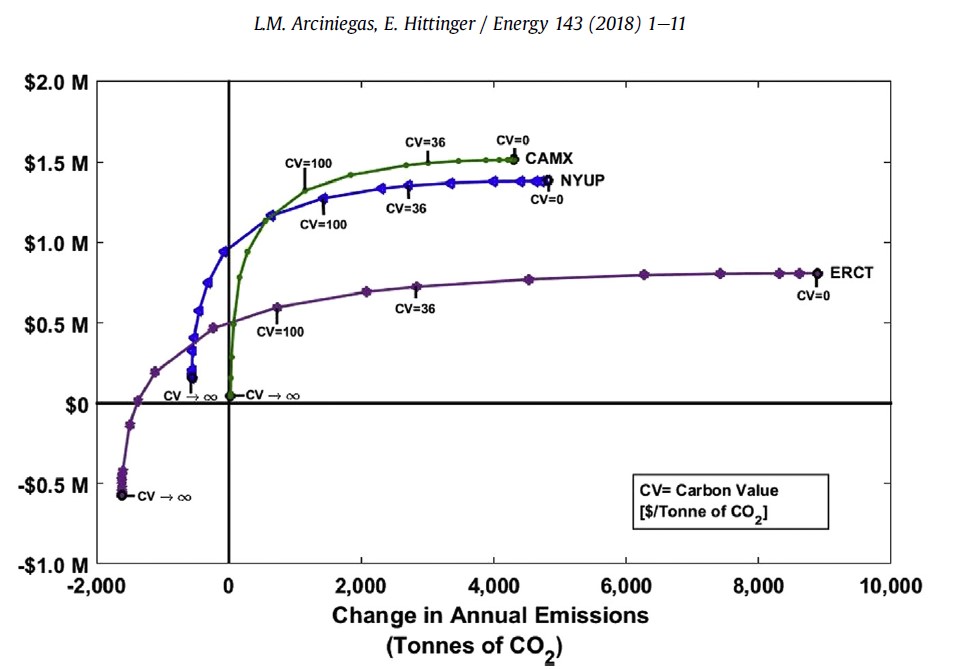
“Casual observers are often wrong.” Why didn’t I think of this for a tagline? It is a line inked by utility veteran Charles Bayless in the March issue of Public Utilities Fortnightly. His article, “Does Storage Increase Carbon?” is the basis of this post.
By the way, many politicians make policy and law without knowing anything about that which they are making policy or laws – as though engineers, scientists, and the private sector simply aren’t trying. Sure. We’re not trying to cure cancer or produce affordable and reliable zero-emission energy. No. There would be no money or fame in solving those issues. Fame, wealth, saving lives, and money are overrated.
But I digress.
There are several benefits of storage:
- Reduce the need for peaker plants – energy intensive generators used to meet peak demand, typically during the hottest weather.
- Relieve transmission congestion – avoids the need to add to or replace expensive transmission systems.
- Frequency regulation – fast delivery of power to maintain the requisite 60 Hz on the North American grid.
- Manage demand, soaking up extra supply and releasing it when needed.
- Provide power for black starts.
How does battery storage increase carbon emissions? The casual observer believes batteries are used to store renewable energy. Ha-ha; not so fast. This is wrong because the cheapest resources supply the grid first, even in the vertically integrated monopolistic Midwest. Renewables, with no incremental cost of production, sell first. Nuclear, which isn’t mentioned in the article, is second. Coal is third (in the Midwest, at least). And natural gas is fourth.
Arbitrage
The reason battery storage increases emissions is simple: arbitrage. I.e., buy low and sell high. As a battery investor, that is my code.
As I have explained a thousand times in this blog, electricity is as unique as bottled water. The wall receptacle provides a nominal 60 Hz power at a nominal 120V, regardless of the source. Unlike municipal water, consumers have no idea where their electricity comes from due to the interconnections of thousands of generators connected to the grid.
Similarly, as a battery owner, I don’t know the source of what I’m buying. I only care about the price. Regardless of where I’m situated, I’m buying electricity to store, and selling at a higher price later.
In the Midwest, we use Wyoming coal from the Powder River Basin. As I explained to the class at the Wisconsin Public Utilities Institute last fall, Powder River coal is still cheaper than, and probably always will be cheaper than, natural gas. Bayless confirms this with pricing examples in his Fortnightly article. Therefore, my battery can be used to store cheap electricity from coal at night, to avoid more costly electricity from natural gas during the day – especially when the wind doesn’t blow, as it tends not to in the dog days of August.
Again, I’m embarrassed I didn’t think of this first, but at least I can share it with my audience. Until now, I considered batteries to mainly be a bridge to store and hold renewable electricity and a frequency regulator. Heck no. Like anything else, I want to buy as low and sell as high as I can. This can include taking garbage electricity, as I mentioned a couple of weeks ago, for two cents and then selling it the next night for twenty cents or more. Wow. I’m not storing renewable energy even in that case. Explanations are coming.
Batteries Are Likely to Always Increase Emissions
This recent study led by an engineer with a Carnegie Mellon Ph.D. explains why batteries increase emissions. With zero carbon cost, battery storage would increase emissions in the eGrid sub-regions of California, Texas, and New York, and probably everywhere in between. The unusual data, which I will explain, are displayed in the following chart.
Each curve represents revenue production and carbon emission change for a 25 MW/100 MWh battery connected to the grid in the three regions mentioned. The curves represent varying costs of carbon or CV for carbon value. Zero carbon cost is the far-right end of the curve. The far left represents near infinite carbon cost. For every reasonable price on carbon, emissions increase with battery storage. NOTICE under all scenarios, batteries NEVER reduce carbon emissions in California. In fact, the only quadrant in the plot that shows profit while reducing emissions is the upper left quadrant: tiny profits equal batteries not cost effective.
Batteries, or any storage, only swap dispatchable, conventional resources; never renewable resources. Result: increased emissions.
So why would batteries always increase emissions in a place like California? It’s pretty simple. The second law of thermodynamics. Every time energy is converted, there are losses. Round-trip charging and discharging a battery requires rectifiers and inverters to convert alternating current to direct current for storage, and back to alternating for discharge. Expensive lithium batteries, which provide near-instant response (frequency modulation), are reported to be 90% efficient, not counting conversions I mentioned. More capacious, but slower, flow batteries are only 75% efficient.
With zero marginal cost, renewable energy is a baseload resource. Conventional sources are always required to maintain grid frequency and voltage, and they operate at the margin. Since batteries also operate only at the margin, they are swapping power from conventional sources only.
Similarly, don’t be fooled that a solar plus storage facility is all solar. That storage is simply trading marginal energy from emission-spewing dispatchable resources located somewhere else.







Join the discussion One Comment